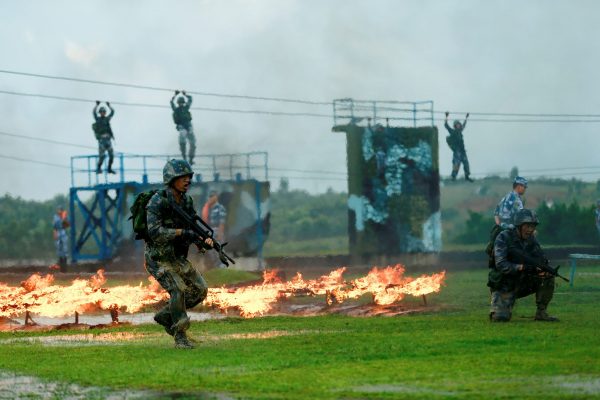Notwithstanding that the PLA has supported its commander-in-chief in his consolidation of power to attain reach his present unassailable position, the extent to which the CCP’s coercive forces can count on China’s new paramount leader to fully translate his considerable political clout into the PLA’s growing professionalisation is open to debate.
The general trend of the PLA’s latest modernisation drive has seen it initiate a nascent transition from an unwieldy Soviet-style model of ‘command and control’ to a more network-centric force that emphasises the networked linkages between platforms as opposed to the platforms themselves.
Even if it is still too early to gauge whether the PLA will successfully transform into a modern and network-enabled force capable of projecting power across the Asia Pacific, the reforms instituted by Xi in his capacity as chairman of the Central Military Commission (as well as his recently proposed enhancements to military theory and organisational structure) have undeniably moved China’s military closer towards that goal.
In accordance with Xi’s vision for his troops as enunciated at the 19th Party Congress — that the PLA modernise itself by 2035 and become a world-class armed forces by 2050 — the PLA has in recent times embraced the new operational concept of ‘informationised warfare’ as it continues to physically upgrade its forces to be on par with the world’s most advanced militaries.
Dismantling and reorganising former general headquarters, military regions and military services was politically expedient in limiting the autonomy of PLA elites vis-a-vis the office of the CMC chairman. In the same vein, the recent reforms have also had the effect of compressing the layers of command and administrative bureaucracy to encourage professionalism of the corps to carry out joint integrated operations more efficiently and effectively.
With the passage of time, this increased mechanisation and informationisation on the back of decades of strong economic growth and greater civil–military integration will result in a better-equipped force that is kitted out with upgraded communications and computing equipment as well as more advanced surveillance and reconnaissance systems. In sum, the PLA will able to be deployed to combat theatres more expeditiously than in the past.
But as the PLA transitions towards a more joint and informationised force, it becomes equally crucial, if not more important, that it also upgrades its ‘heartware’ — the less tangible aspects of its development, including operational culture and military ethos. This is necessary to effect complementary changes to its organisation and doctrine as well as the training of its officers and members of the rank-and-file.
With authoritative commentaries in the PLA Daily stipulating that the key source of resistance to the military reforms ‘comes from within’, it becomes clear that the indictments of military ‘tigers’ were partly to punish military leaders who had compromised civilian authority. More importantly, they also serve as a warning to the rest of the corps not to stand in the way of reforms.
In the near to medium term, the PLA may well be confronted with even greater challenges in carrying out the deeper ‘below the neck’ reforms that go beyond simply revising its operational and administrative structures. Indeed, any fundamental change to Chinese military ‘heartware’ may well take a few generations to accomplish.
Xi Jinping’s ability to reject established Party succession norms can be attributed to the fact that the PLA has thrown its weight behind its civilian commander-in-chief as the latter asserts himself against other Party elites. In return, the CMC chairman has appealed to the PLA’s corporate interests by enhancing the status of the military profession and by according it pride of place in the regime.
Following the crisis of legitimacy that had plagued the PLA during the period of decadence in which military malfeasance was widespread — with some of China’s top soldiers going as far as disobeying the legitimate civilian command of the previous commander-in-chief — Xi has since reshaped the establishment to exercise decisive influence over military affairs, and by extension how the Party and the state are run.
Breaking traditions and military routines is clearly a formidable if not impossible task. Moreover, further game-changing upgrades of PLA hardware may also be face obstacles, with slowing economic growth rates meaning that robustness of China’s military–industrial development cannot be taken for granted in the longer term.
The PLA is now at a critical phase in its evolution. Its success — or lack thereof — in effecting qualitative changes to both its hardware and ‘heartware’ will determine whether Beijing will be able to deal with a greater number of contingencies and new missions further away from Chinese shores.
James Char is Associate Research Fellow with the China Programme at the S. Rajaratnam School of International Studies (RSIS), Nanyang Technological University, Singapore.
Richard A Bitzinger is Senior Fellow and Programme Coordinator of the Military Transformations Programme at RSIS, Nanyang Technological University, Singapore.
They are the co-editors of the special section ‘The People’s Liberation Army in the Xi Jinping Era’ in the latest volume of The China Quarterly.
A version of this article was first published here by RSIS.

